Why the Wimbledon tennis championship is a year-long affair
- Published

Wimbledon boss Richard Lewis on the Centre Court at Wimbledon
With the Australian Open now over, it is not only tennis players and fans who are casting a keen eye towards the start dates of the next two Grand Slams in Europe.
Staff at Roland Garros in Paris, and at the All England Lawn Tennis Club (AELTC) in London, will be fine-tuning their preparations over the spring, so that when they open their doors for two weeks of tennis everything is pitch perfect.
But what happens at a major Grand Slam tennis venue in the other 50 weeks of the year?
At Wimbledon, preparations for the 2015 tournament actually began on the last day of the 2014 event.
So making a visit to the SW19 complex on a cold winter's day means entering a hive of activity, with engineers, gardeners, delivery men and other members of the 150-strong full-time staff buzzing about the 40-acre site.
"The first tournament debrief takes place on the morning of the men's final," Richard Lewis, chief executive of the AELTC tells the BBC.
Following that initial brief report to the tournament's management committee, they meet again 10 days later, to further exchange views and impressions.
"I add findings from other debriefs that have taken place after the event, such as with Group 4 Security, and the volunteer stewards.
"Members of staff will also have been able to give their observations via their line managers," says Lewis, who has recently returned from the Australian Open in Melbourne.
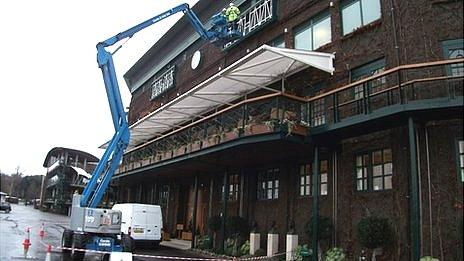
Work goes on all year round at the club
"We put everything under the microscope," says the former British Davis Cup tennis player. "We look at what went well, and consider what could be improved for the year ahead."
He says the reason for the debrief 10 days after the championship enables "a quick response to any urgent issues", before major work for the following year's showcase event begins.
Building projects
Two to three weeks after the championships end, work starts on the next phase of infrastructure work.
The club currently has four big building programmes under way for the 2015 Championships:
One building programme includes the following:
Courts 14 and 15 being rebuilt over a new underground storage facility big enough to hold 200 double-decker buses
A new restaurant and changing rooms for ballboys and ballgirls
A new photographers' area
A new restaurant for the media

Extra underground storage space is being created near the press centre
Another programme will see the upgrading of facilities for players, including indoor practice area and running track.
Meanwhile, a construction compound is being created ahead of the work to put a roof on Court One.
Finally, refurbishment will take place of the Millennium Building, which opened in 2000 and provides accommodation and facilities for players, club members and the media.
The four big projects will cost millions of pounds, while Lewis says there are another 64 projects (this is a busy year, 50 is normal) under way, costing anything from £10,000 to £1m each.
"As you can see, a lot of my time during the year is spent on planning the building or refurbishing of facilities," says Lewis.
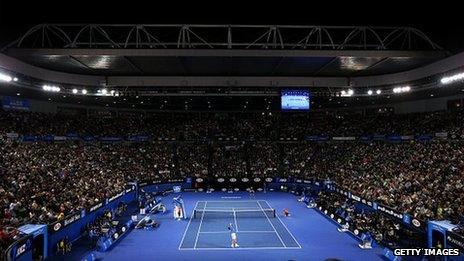
Visiting other sports venues is important in a competitive leisure market, says Richard Lewis, who has just returned from Melbourne
'Constantly reinvesting'
Time is also spent visiting the other three Grand Slam events, in Australia, France and the US.
The recent Melbourne trip enabled Lewis to see how the Australian complex has installed retractable roofs over three courts, particularly useful with the AELTC having recently received planning permission to put a roof on Court One at Wimbledon.
Lewis says the constant upgrades are needed in an increasingly competitive global leisure market.
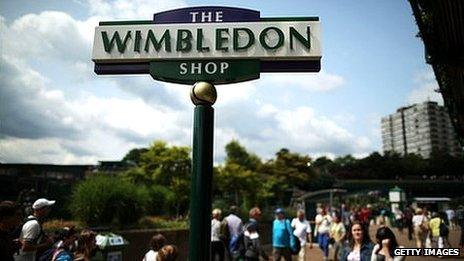
The club is open to visitors throughout the year
"I don't think we are just competing with other tennis events, we are competing with other sports events and entertainment destinations - it is natural that we constantly reinvest," he says.
As well as major infrastructure works, all courts are renovated each year, the surrounding gardens and foliage need tending to all year round, and cosmetic repairs are carried out on existing structures.
As well as the ongoing physical work, Wimbledon continues to operate throughout the year as a sporting, social and charitable enterprise.
Marketing the brand
The AELTC is a club like any other tennis club, albeit with more grandiose facilities, and Lewis has to attend to the requirements of the members.
"We have tennis matches against other clubs, we host other clubs from overseas, and - like any other normal club - we also have social events, such as croquet and bridge events," he says.
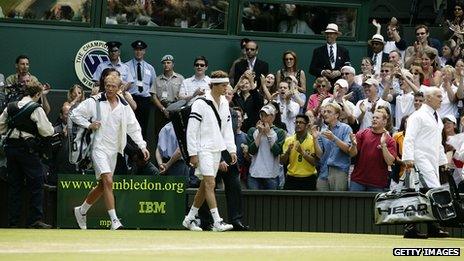
The 2004 movie Wimbledon, featuring Paul Bettany (left) was one of the rare productions allowed to film at the venue
Also open to the public around the year are the club tours, shop and museum, with the latter bringing in 90,000 visitors a year.
"What we make from this is negligible in terms of the overall financial picture," he says. "It is about providing a service rather than thinking about how much money we can make out of these.
"But from a business point of view it provides us with an opportunity to market the brand heritage to these visitors."
And while global visitors go away with a new sense of British tradition, the club also has a strong focus on interacting with the local community. Lewis says the value of this was impressed upon him during his time as boss of the Rugby Football League.
Charitable links
Function space is available for use throughout the year for organisations the AELTC has links with, such as the London Borough of Merton, whose mayor hosts awards events there.
"It is not about who pays the most," says Lewis, adding that many commercial requests, such as to film either adverts or movies at the venue, are turned down.
"We strategically take the point of view that the more we build up the brand, the finances take care of themselves. We are fortunate to be able to take a long-term view of things."
However, official AELTC commercial partners have been allowed to film promotional material in the hallowed grounds, as have some TV programmes if they are featuring former Wimbledon stars.
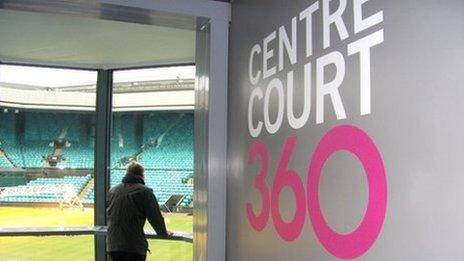
Visitor attractions, such as Centre Court 360, are open all year, except for during the fortnight of the Championship
Meanwhile, the Wimbledon Foundation is a registered charity that combines charitable donations and money from ticket re-sales during the championships fortnight - with whatever is raised from the latter being matched by one of the club's partners, HSBC bank.
"We give money to local charities. We have our traditional charities, such as the armed forces and ambulance service - people who provide volunteers for the championships," says Lewis. "And we are now also asking local community groups to apply for charitable grants."
'Moving forward'
On the playing side, during the year the AELTC hosts the Road to Wimbledon Under-14 national tournament, as well as other events such as seniors tournaments, armed forces events, and it also hosts UK clubs that are celebrating their centenary.
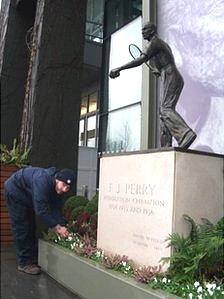
Tending to the flowers at the Fred Perry statue
The club's Wimbledon Junior Tennis Initiative also runs throughout the year, going into schools and inviting youngsters to SW19.
As well as playing guidance, head coach Dan Bloxham and his team pass on tips from top players like Roger Federer and Rafael Nadal, such as good diet and nutrition, and about listening to your sports coaches and teachers.
Outside of the UK it is part of the Grand Slam Development Fund, that helps young players from developing nations take part in global events. It also helps to develop grass court tournaments around the world by offering technical expertise and financial assistance.
"From a business point of view, we want to consolidate our heritage but also continually improve the way we do things," says Lewis.
"We are always looking for new and better ways of doing things. Whether it be new infrastructure, our digital media offering, or even ways of getting customer feedback - we are always moving forward."